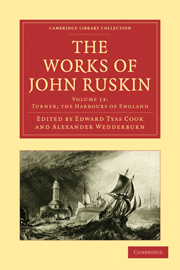Book contents
- Frontmatter
- Contents
- LIST OF ILLUSTRATIONS
- INTRODUCTION TO THIS VOLUME
- PART I
- PART II TURNER'S WORKS AT THE NATIONAL GALLERY
- PART III
- APPENDIX
- I PICTURE GALLERIES; THEIR FUNCTIONS AND FORMATION—EVIDENCE GIVEN BY RUSKIN TO THE NATIONAL GALLERY SITE COMMISSION, APRIL 6, 1857
- II THE CHARACTER OF TURNER
- III MINOR CATALOGUES OF TURNER DRAWINGS
- IV LETTERS ON COPIES OF DRAWINGS BY TURNER
- V TURNERS, FALSE AND TRUE (1871, 1884)
- VI “NOTES ON DRAWINGS BY MR. RUSKIN PLACED ON EXHIBITION BY PROFESSOR NORTON,” AT BOSTON AND NEW YORK, 1879
- VII LIGHT AND WATER-COLOURS
- INDEX
I - PICTURE GALLERIES; THEIR FUNCTIONS AND FORMATION—EVIDENCE GIVEN BY RUSKIN TO THE NATIONAL GALLERY SITE COMMISSION, APRIL 6, 1857
Published online by Cambridge University Press: 05 April 2012
- Frontmatter
- Contents
- LIST OF ILLUSTRATIONS
- INTRODUCTION TO THIS VOLUME
- PART I
- PART II TURNER'S WORKS AT THE NATIONAL GALLERY
- PART III
- APPENDIX
- I PICTURE GALLERIES; THEIR FUNCTIONS AND FORMATION—EVIDENCE GIVEN BY RUSKIN TO THE NATIONAL GALLERY SITE COMMISSION, APRIL 6, 1857
- II THE CHARACTER OF TURNER
- III MINOR CATALOGUES OF TURNER DRAWINGS
- IV LETTERS ON COPIES OF DRAWINGS BY TURNER
- V TURNERS, FALSE AND TRUE (1871, 1884)
- VI “NOTES ON DRAWINGS BY MR. RUSKIN PLACED ON EXHIBITION BY PROFESSOR NORTON,” AT BOSTON AND NEW YORK, 1879
- VII LIGHT AND WATER-COLOURS
- INDEX
Summary
THE NATIONAL GALLERY SITE COMMISSION
Evidence of John Ruskin, Monday, April 6, 1857
1. Chairman. Has your attention been turned to the desirableness of uniting sculpture with painting under the same roof?—Yes.
2. What is your opinion on the subject?—I think it almost essential that they should be united, if a National Gallery is to be of service in teaching the course of art.
3. Sculpture of all kinds, or only ancient sculpture?—Of all kinds.
4. Do you think that the sculpture in the British Museum should be in the same building with the pictures in the National Gallery, that is to say, making an application of your principle to that particular case?—Yes, certainly; I think so for several reasons—chiefly because I think the taste of the nation can only be rightly directed by having always sculpture and painting visible together. Many of the highest and best points of painting, I think, can only be discerned after some discipline of the eye by sculpture. That is one very essential reason. I think that after looking at sculpture one feels the grace of composition infinitely more, and one also feels how that grace of composition was reached by the painter.
5. Do you consider that if works of sculpture and works of painting were placed in the same gallery, the same light would be useful for both of them?
- Type
- Chapter
- Information
- The Works of John Ruskin , pp. 539 - 553Publisher: Cambridge University PressPrint publication year: 2010First published in: 1904



